A Comparative Analysis of Runoff and Soil Loss Characteristics between “Extreme Precipitation Year” and “Normal Precipitation Year” at the Plot Scale: A Case Study in the Loess Plateau in China
Abstract
:1. Introduction
2. Materials and Methods
2.1. Study Area
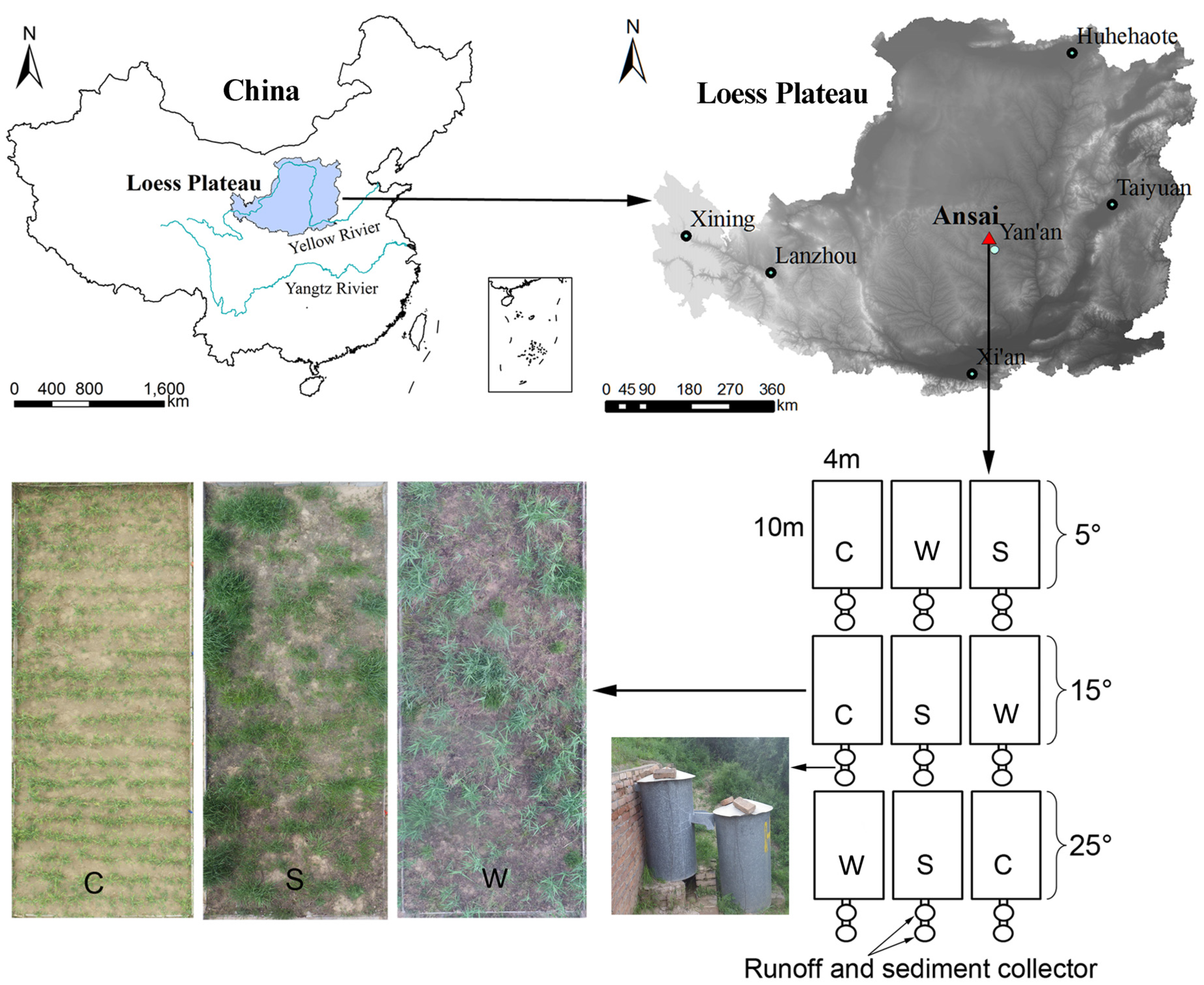
2.2. Runoff Plot Design
2.3. Data Collection and Calculation
2.3.1. Compilation of Rainfall Data over the Past 60 Years
2.3.2. Monitoring and Calculation of the Rainfall Parameters
2.3.3. Determination of Extreme Rainfall
2.3.4. Monitoring Runoff, Soil Loss and Nutrient Loss
2.4. Data Analysis
3. Results and Discussion
3.1. Annual Rainfall Amount and Monthly Rainfall Distribution in the “Extreme Year”
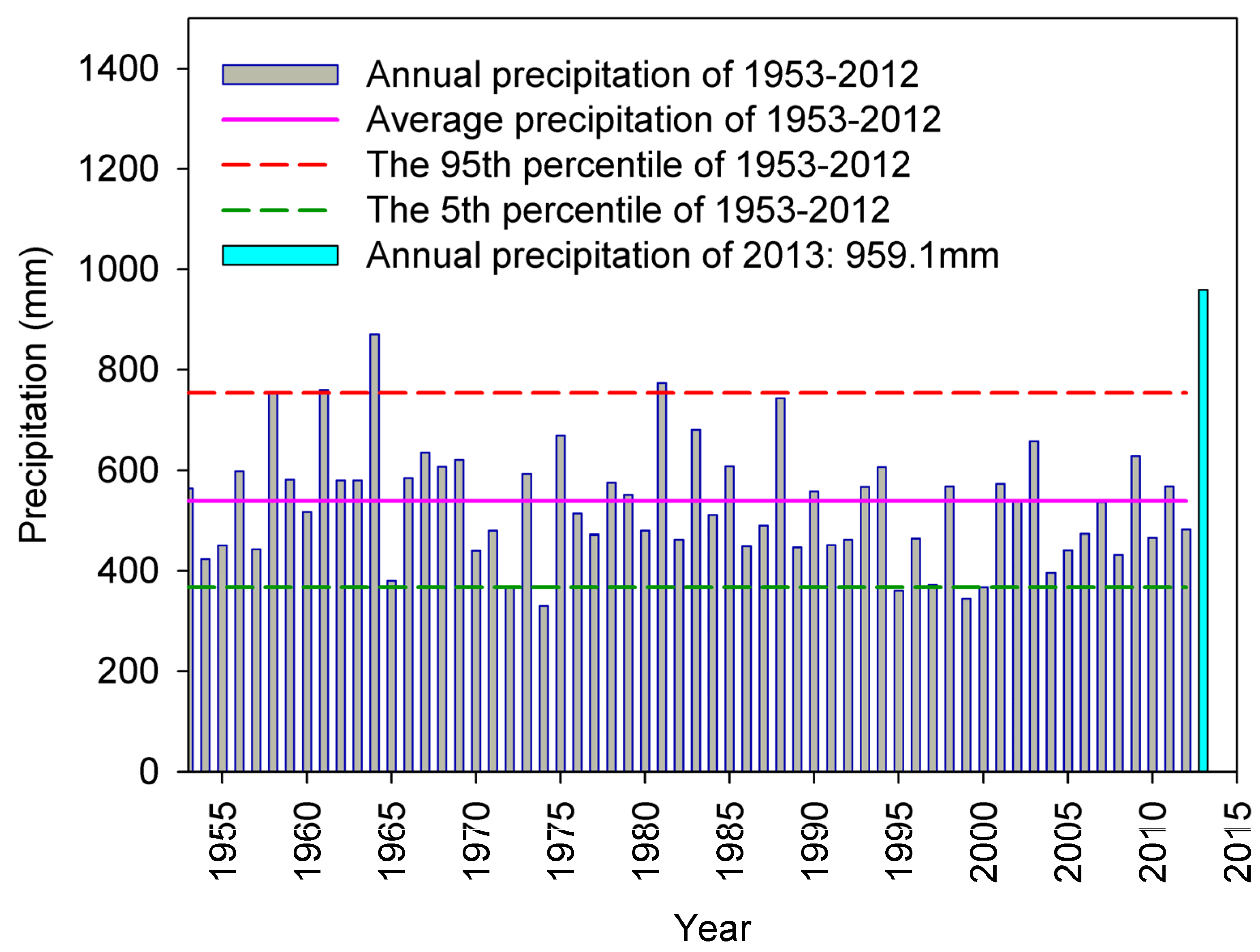
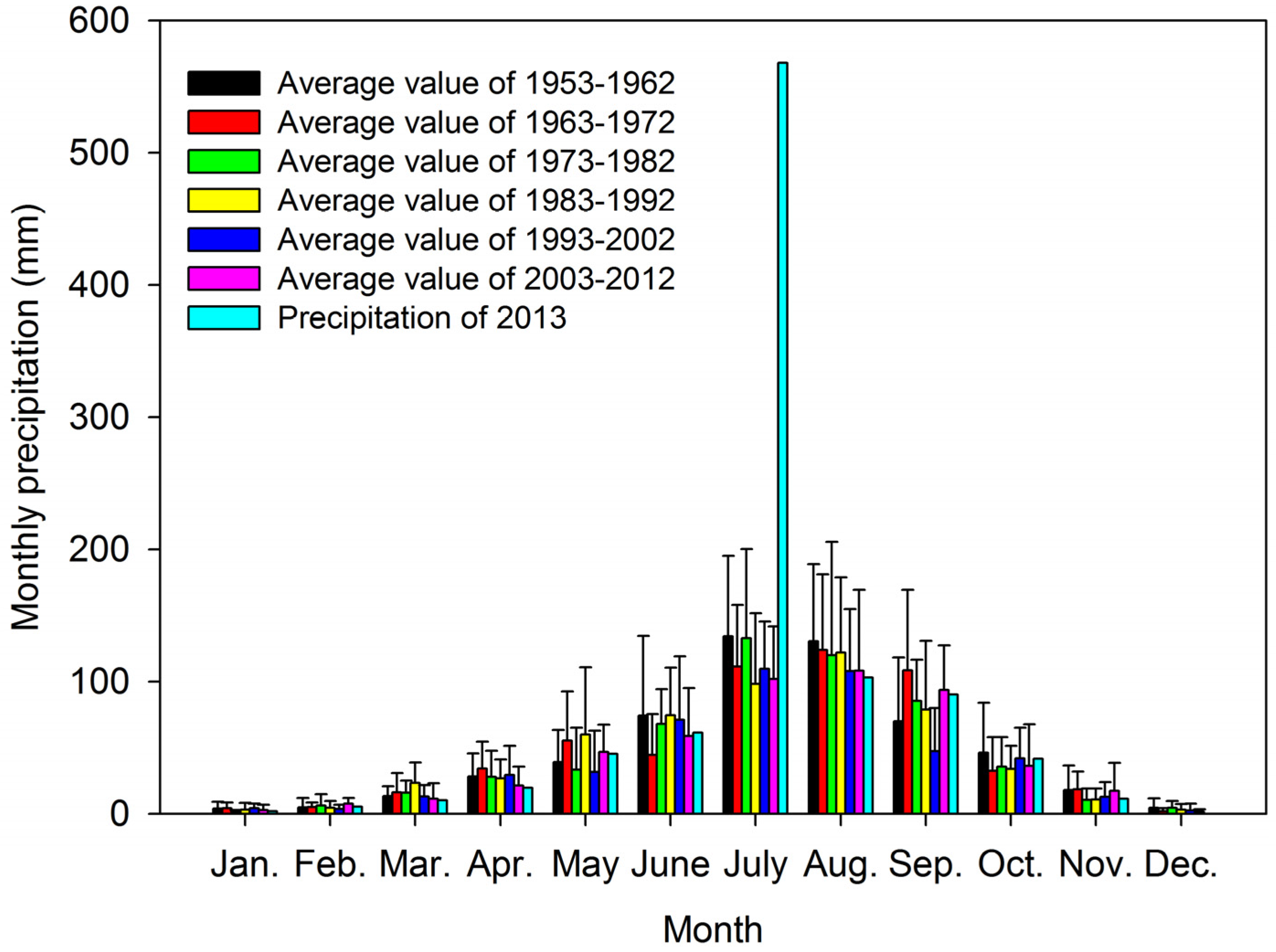
3.2. Runoff Depth and Soil Losses in Rainfall Events from 2010 to 2013
| Date | Rainfall (mm) | API a (mm) | EI30 b | W | S | C | |||
|---|---|---|---|---|---|---|---|---|---|
| Runoff Depth (mm) | Soil Loss (t/ha) | Runoff Depth (mm) | Soil Loss (t/ha) | Runoff Depth (mm) | Soil Loss (t/ha) | ||||
| 11 August 2010 | 50.0 | 15.3 | 273.1 | 1.3 | 0.008 | 2.3 | 0.030 | 5.4 | 2.001 |
| 20 August 2010 | 33.0 | 11.4 | 38.1 | 0.0 | 0.000 | 0.2 | 0.000 | 0.4 | 0.033 |
| 21 August 2010 | 34.8 | 37.8 | 55.7 | 0.1 | 0.000 | 0.3 | 0.000 | 1.1 | 0.015 |
| Sum | 117.8 | 64.5 | 366.8 | 1.4 | 0.008 | 2.9 | 0.030 | 6.9 | 2.049 |
| 24 July 2011 | 10.4 | 4.5 | 39.1 | 0.1 | 0.000 | 0.2 | 0.003 | 0.4 | 0.028 |
| 30 July 2011 | 42.8 | 13.1 | 133.0 | 1.3 | 0.004 | 1.6 | 0.007 | 4.8 | 0.634 |
| 14 August 2011 | 43.4 | 26.8 | 365.0 | 1.8 | 0.029 | 3.4 | 0.071 | 7.1 | 3.360 |
| 18 August 2011 | 68.2 | 21.8 | 61.3 | 0.0 | 0.000 | 0.4 | 0.002 | 0.6 | 0.035 |
| 23 August 2011 | 22.6 | 29.5 | 28.7 | 0.0 | 0.025 | 0.0 | 0.000 | 0.5 | 0.056 |
| Sum | 187.4 | 95.6 | 627.2 | 3.1 | 0.058 | 5.6 | 0.082 | 13.3 | 4.112 |
| 24 June 2012 | 32.1 | 0.0 | 67.2 | 0.1 | 0.000 | 0.1 | 0.000 | 0.5 | 0.019 |
| 15 July 2012 | 14.4 | 7.4 | 75.6 | 0.3 | 0.004 | 0.2 | 0.007 | 0.7 | 0.292 |
| 21 July 2012 | 54.4 | 8.3 | 149.2 | 0.4 | 0.001 | 0.7 | 0.005 | 3.0 | 0.057 |
| 13 August 2012 | 12.4 | 6.5 | 6.7 | 0.0 | 0.000 | 0.0 | 0.000 | 0.2 | 0.004 |
| 18 August 2012 | 55.0 | 9.6 | 81.3 | 0.3 | 0.000 | 0.2 | 0.005 | 1.0 | 0.006 |
| 20 August 2012 | 7.0 | 40.1 | 18.4 | 0.1 | 0.000 | 0.2 | 0.005 | 0.5 | 0.049 |
| 6 September 2012 | 28.4 | 17.7 | 177.8 | 1.7 | 0.015 | 2.2 | 0.027 | 4.8 | 0.595 |
| Sum | 203.7 | 89.5 | 576.3 | 2.9 | 2.0 | 3.6 | 0.048 | 10.8 | 1.022 |
| 20 June 2013 | 40.4 | 2.7 | 71.2 | 0.3 | 0.000 | 0.4 | 0.000 | 0.6 | 0.005 |
| 4 July 2013 | 54.4 | 29.2 | 235.7 | 4.1 | 0.169 | 4.5 | 0.104 | 8.4 | 5.169 |
| 9 July 2013 | 96.6 | 60.1 | 466.0 | 5.0 | 0.742 | 9.1 | 0.709 | 15.5 | 10.741 |
| 13 July 2013 | 96.6 | 71.0 | 205.8 | 3.3 | 0.067 | 5.0 | 0.315 | 6.7 | 5.302 |
| 27 July 2013 | 67.6 | 48.0 | 156.9 | 2.8 | 0.020 | 4.0 | 0.179 | 10.4 | 4.612 |
| 7 August 2013 | 13.4 | 15.1 | 5.7 | 0.0 | 0.000 | 0.0 | 0.000 | 0.2 | 0.059 |
| 11 August 2013 | 14.6 | 15.5 | 74.8 | 1.3 | 0.055 | 3.0 | 0.037 | 3.3 | 4.027 |
| 24 August 2013 | 57.0 | 16.3 | 305.9 | 1.6 | 0.015 | 3.0 | 0.177 | 7.2 | 4.470 |
| 25 August 2013 | 8.4 | 42.6 | 7.4 | 0.1 | 0.000 | 0.5 | 0.006 | 2.9 | 0.493 |
| 23 September 2013 | 34.4 | 16.9 | 19.9 | 0.3 | 0.000 | 0.4 | 0.000 | 1.5 | 0.014 |
| Sum | 483.4 | 317.4 | 1549.4 | 18.8 | 1.069 | 29.9 | 1.528 | 56.6 | 34.892 |

3.3. Comparing the Monthly Rainfall Characteristics in the “Extreme Year” with Those in the “Normal Year”
| Month | Year | Rainfall (mm) | Rainfall Duration (h) | E a | EI5 b | EI10 b | EI20 b | EI30 b | EI60 b |
|---|---|---|---|---|---|---|---|---|---|
| June | 2010–2012 | 49.1 | 42.9 | 4.1 | 61.1 | 55.6 | 46.4 | 41.0 | 33.9 |
| 2013 | 79.8 | 48.6 | 4.9 | 118.7 | 89.0 | 83.1 | 71.2 | 54.4 | |
| Change rate (%) | 62.4 | 13.4 | 19.5 | 94.2 | 60.2 | 78.9 | 73.8 | 60.7 | |
| July | 2010–2012 | 98.3 | 45.7 | 9.4 | 373.9 | 247.7 | 193.1 | 153.0 | 114.0 |
| 2013 | 515.4 | 169.5 | 47.9 | 1850.1 | 1533.6 | 1285.4 | 1064.5 | 754.0 | |
| Change rate (%) | 424.5 | 270.9 | 407.2 | 394.8 | 519.2 | 565.8 | 595.7 | 561.5 | |
| August | 2010–2012 | 117.3 | 51.6 | 16.2 | 648.5 | 503.1 | 411.6 | 314.4 | 242.0 |
| 2013 | 154.4 | 38.5 | 16.6 | 721.6 | 583.2 | 452.8 | 393.8 | 331.1 | |
| Change rate (%) | 31.7 | −25.4 | 3.1 | 11.3 | 15.9 | 10.0 | 25.2 | 36.8 | |
| September | 2010–2012 | 91.4 | 42.8 | 5.1 | 156.5 | 127.6 | 102.1 | 82.1 | 59.4 |
| 2013 | 92.4 | 58.9 | 4.7 | 48.3 | 45.3 | 36.5 | 31.8 | 23.0 | |
| Change rate (%) | 1.1 | 37.6 | −8.4 | −69.1 | −64.5 | −64.3 | −61.3 | −61.3 |
3.4. Comparing the Monthly Runoff Depth and Runoff Coefficients in the “Extreme Year” with Those in the “Normal Year” for Three Land Use Types
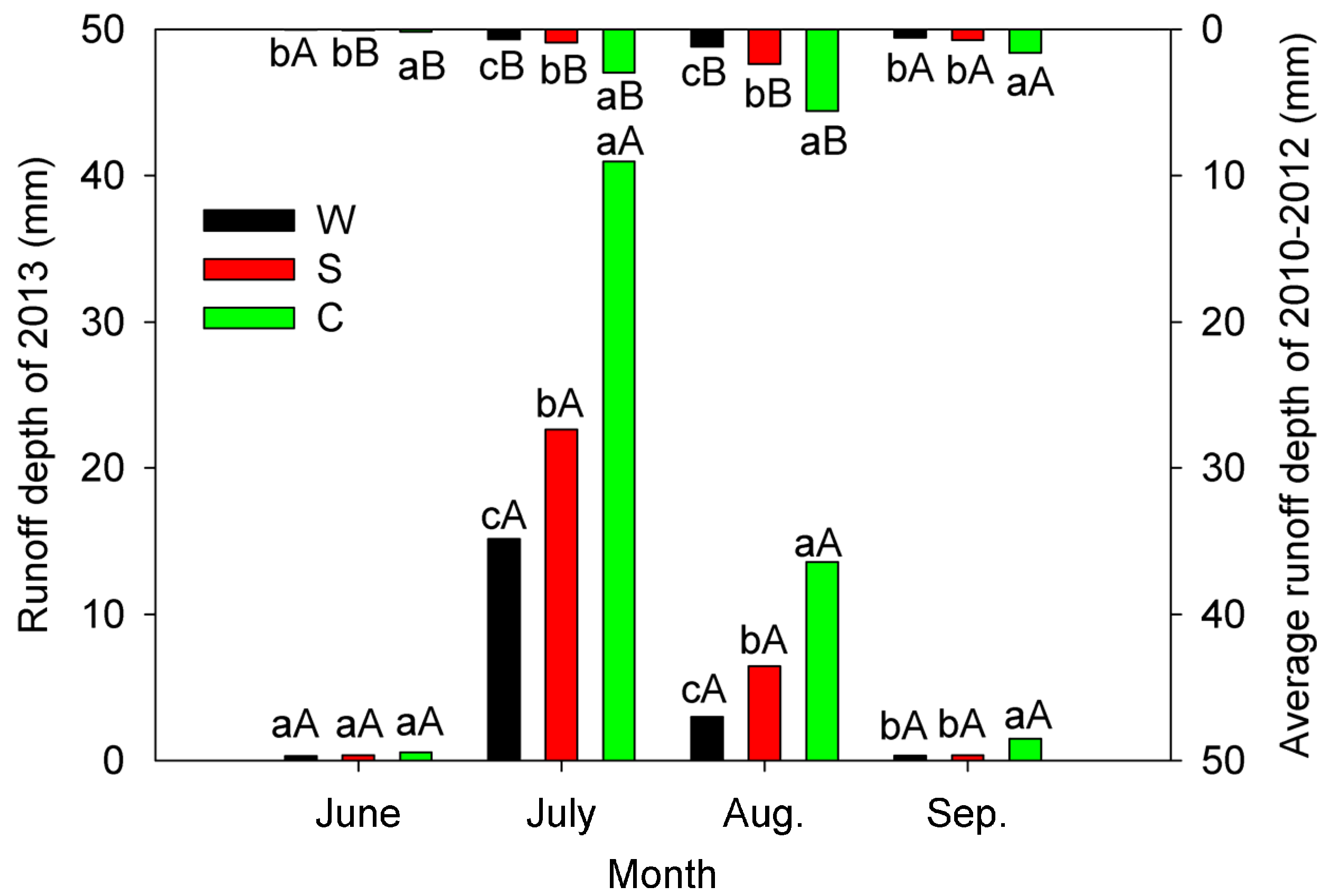
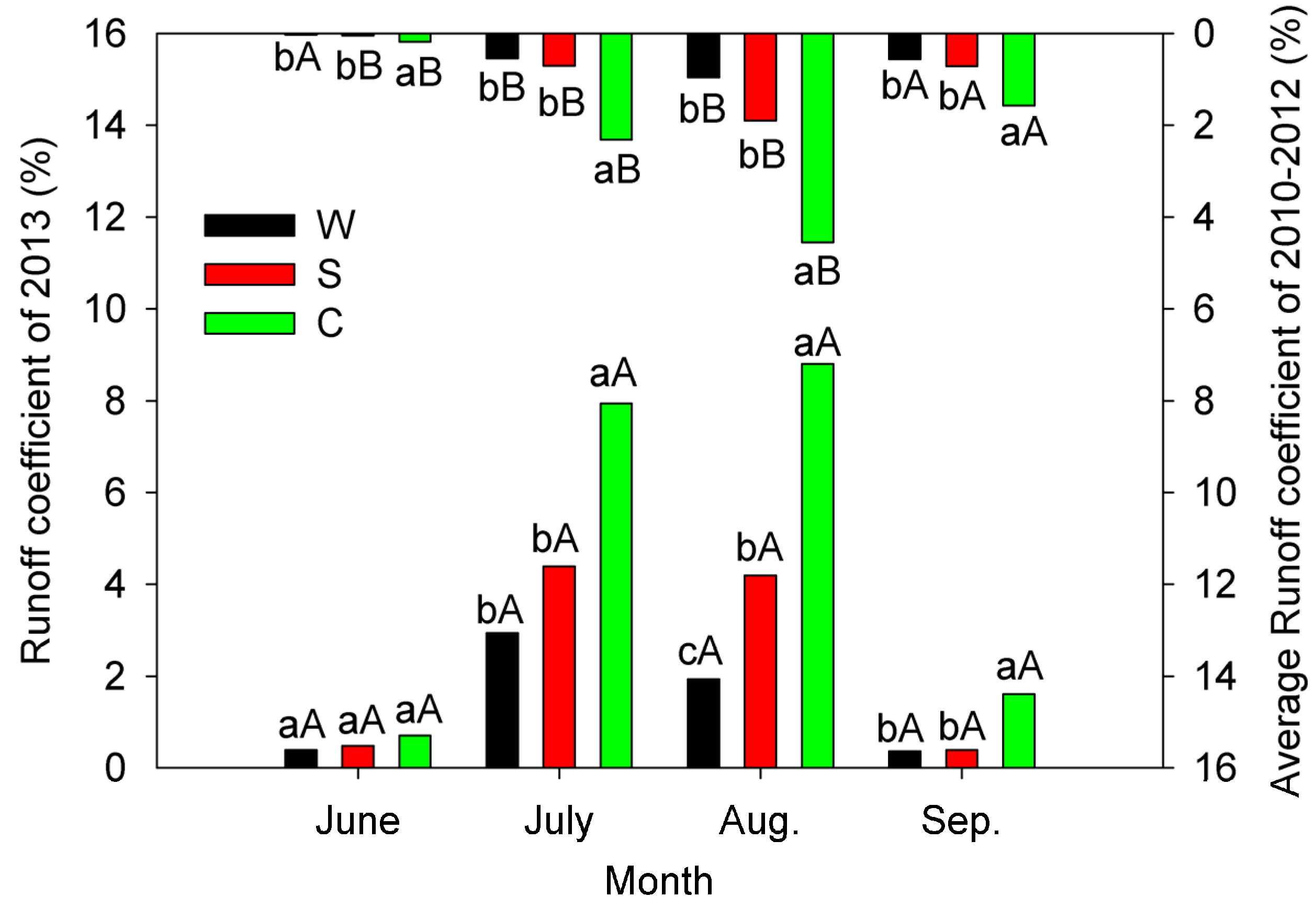
3.5. Comparing the Monthly Soil Losses in the “Extreme Year” with Those in the “Normal Year” for Three Land Use Types
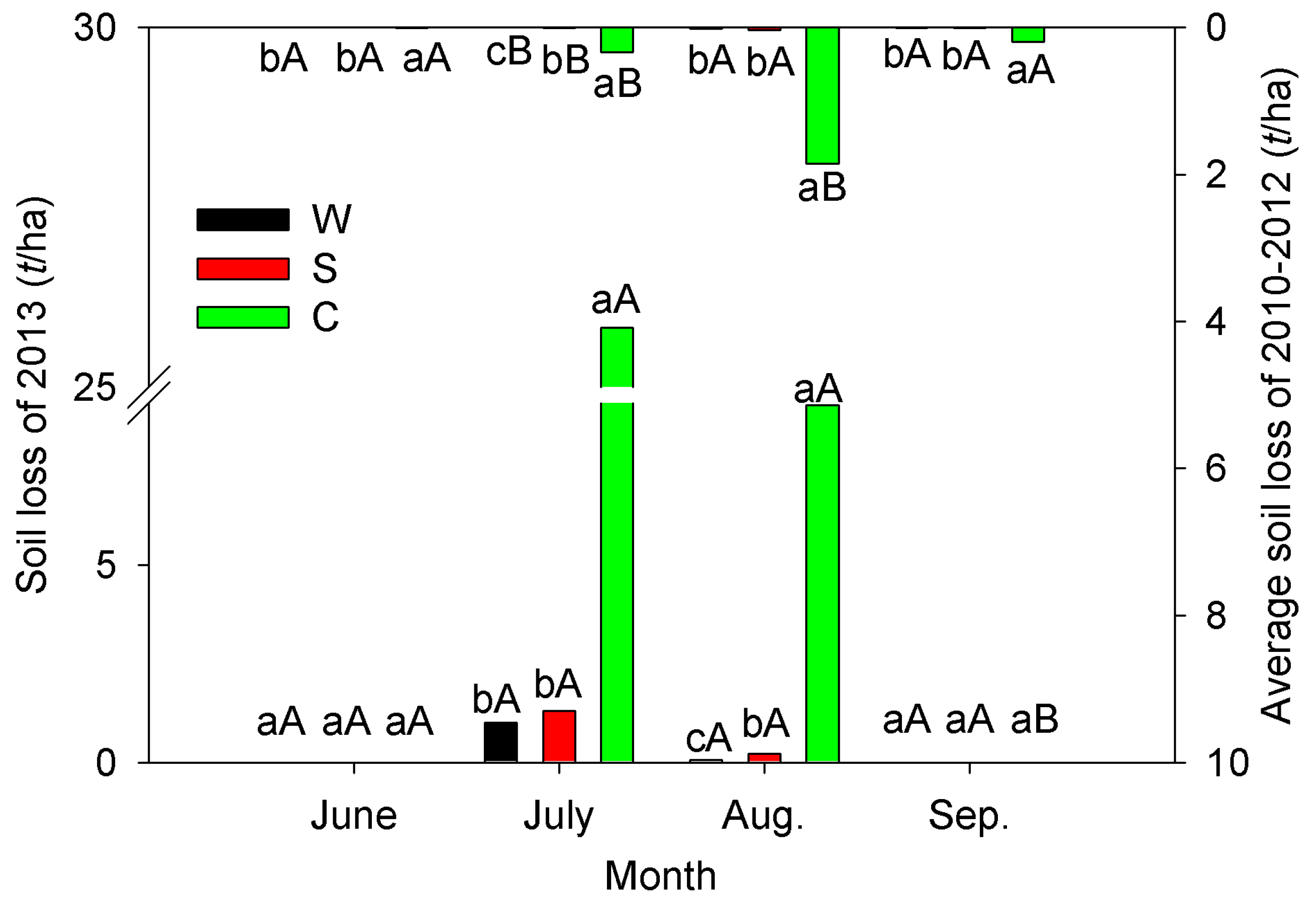
3.6. Comparing the Soil Nutrient Losses Characteristics in the “Extreme Year” with Those in the “Normal Year”


3.7. Sediment Particle Size Distributions in the “Extreme Year” and “Normal Year”
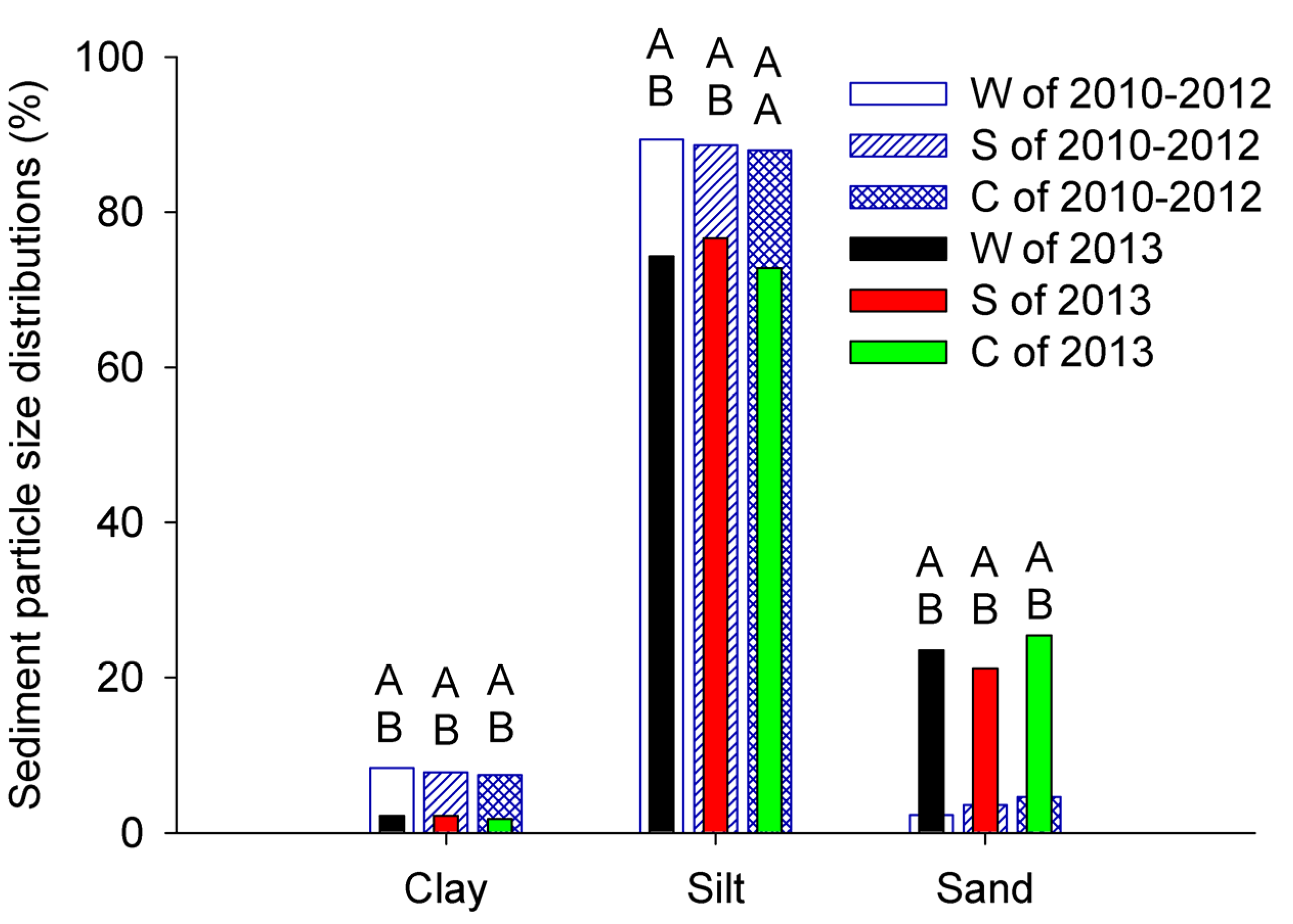
3.8. Pearson Correlation Analysis between the Runoff Depths, Soil Losses and Rainfall Parameters
| Year | Land Use | Runoff Depth and Soil Loss | Rainfall Amount | API | E | EI5 | EI10 | EI20 | EI30 | EI60 |
|---|---|---|---|---|---|---|---|---|---|---|
| 2010–2012 (N = 15) | W | Runoff depth | 0.262 | 0.062 | 0.673 ** | 0.737 ** | 0.835 ** | 0.827 ** | 0.883 ** | 0.865 ** |
| Soil loss | 0.008 | 0.351 | 0.327 | 0.396 | 0.558 * | 0.528 * | 0.596 * | 0.533 * | ||
| S | Runoff depth | 0.337 | 0.149 | 0.745 ** | 0.806 ** | 0.915 ** | 0.908 ** | 0.951 ** | 0.937 ** | |
| Soil loss | 0.197 | 0.193 | 0.618 * | 0.725 ** | 0.881 ** | 0.863 ** | 0.919 ** | 0.866 ** | ||
| C | Runoff depth | 0.379 | 0.099 | 0.786 ** | 0.833 ** | 0.906 ** | 0.905 ** | 0.945 ** | 0.943 ** | |
| Soil loss | 0.246 | 0.173 | 0.667 ** | 0.775 ** | 0.914 ** | 0.906 ** | 0.929 ** | 0.897 ** | ||
| 2013 (N = 10) | W | Runoff depth | 0.835 ** | 0.671 * | 0.893 ** | 0.901 ** | 0.890 ** | 0.865 ** | 0.859 ** | 0.798 ** |
| Soil loss | 0.582 | 0.483 | 0.616 | 0.825 ** | 0.830 ** | 0.844 ** | 0.790 ** | 0.650 * | ||
| S | Runoff depth | 0.822 ** | 0.694 * | 0.884 ** | 0.959 ** | 0.950 ** | 0.925 ** | 0.905 ** | 0.814 ** | |
| Soil loss | 0.831 ** | 0.706 * | 0.846 ** | 0.911 ** | 0.908 ** | 0.914 ** | 0.890 ** | 0.781 ** | ||
| C | Runoff depth | 0.790 ** | 0.679 * | 0.864 ** | 0.927 ** | 0.937 ** | 0.916 ** | 0.898 ** | 0.828 ** | |
| Soil loss | 0.778 ** | 0.637 * | 0.868 ** | 0.975 ** | 0.968 ** | 0.942 ** | 0.924 ** | 0.848 ** |
3.9. The Effect of Rainfall Erosivity (EI30) on Runoff and Soil Losses
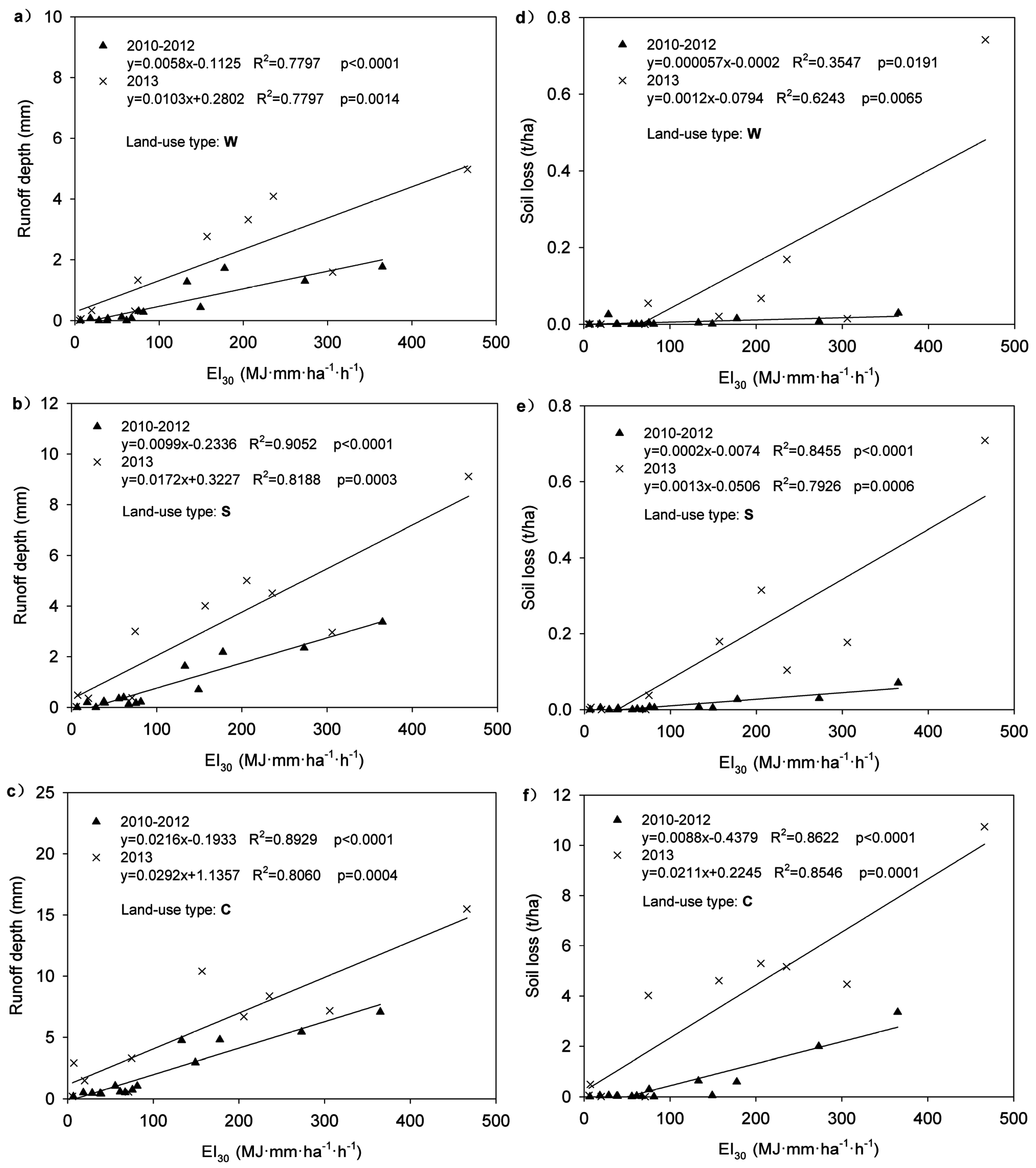
4. Conclusions
Acknowledgments
Author Contributions
Conflicts of Interest
References
- Fang, H.Y.; Cai, Q.G.; Chen, H.; Li, Q.Y. Effect of rainfall regime and slope on runoff in a gullied loess region on the Loess Plateau in China. Environ. Manag. 2008, 42, 402–411. [Google Scholar] [CrossRef] [PubMed]
- Wei, L.; Zhang, B.; Wang, M. Effects of antecedent soil moisture on runoff and soil erosion in alley cropping systems. Agric. Water Manag. 2007, 94, 54–62. [Google Scholar] [CrossRef]
- McCarthy, J.J.; Canziani, O.F.; Leary, N.A.; Dokken, D.J.; White, K.S. Climate Change 2001: Impacts, Adaptation and Vulnerability: Contribution of Working Group II to the Third Assessment Report of the Intergovernmental Panel on Climate Change; Cambridge University Press: New York, NY, USA, 2001; pp. 735–800. [Google Scholar]
- Karl, T.R. Regional trends and variations of temperature and precipitation. In The Regional Impacts of Climate Change: An Assessment of Vulnerability; Watson, R.T., Zyinyowera, M.C., Moss, R.H., Eds.; Cambridge University Press: New York, NY, USA, 1998; pp. 411–437. [Google Scholar]
- Ramos, M.C.; Martínez-Casasnovas, J.A. Trends in precipitation concentration and extremes in the Mediterranean Penedes-Anoia region, NE Spain. Clim. Chang. 2006, 74, 457–474. [Google Scholar] [CrossRef]
- Terink, W.; Immerzeel, W.W.; Droogers, P. Climate change projections of precipitation and reference evapotranspiration for the Middle East and Northern Africa until 2050. Int. J. Climatol. 2013, 33, 3055–3072. [Google Scholar] [CrossRef]
- Li, J.; Zhang, Q.; Chen, Y.D.; Singh, V.P. Future joint probability behaviors of precipitation extremes across China: Spatiotemporal patterns and implications for flood and drought hazards. Glob. Planet Chang. 2015, 124, 107–122. [Google Scholar] [CrossRef]
- Katz, R.W.; Brown, B.G. Extreme events in a changing climate: Variability is more important than averages. Clim. Chang. 1992, 21, 289–302. [Google Scholar] [CrossRef]
- Wagner, D. Scenarios of extreme temperature events. Clim. Chang. 1996, 33, 385–407. [Google Scholar] [CrossRef]
- Groisman, P.Y.; Knight, R.W.; Easterling, D.R.; Karl, T.R.; Hegerl, G.C.; Razuvaev, V.N. Trends in intense precipitation in the climate record. J. Clim. 2005, 18, 1326–1350. [Google Scholar] [CrossRef]
- Easterling, D.R.; Meehl, G.A.; Parmesan, C.; Changnon, S.A.; Karl, T.R.; Mearns, L.O. Climate extremes: Observations, modeling, and impacts. Science 2000, 289, 2068–2074. [Google Scholar] [CrossRef] [PubMed]
- Zhang, X.C.; Liu, W.Z. Simulating potential response of hydrology, soil erosion, and crop productivity to climate change in Changwu tableland region on the Loess Plateau of China. Agric. For. Meteorol. 2005, 131, 127–142. [Google Scholar] [CrossRef]
- Favis-Mortlock, D.; Boardman, J. Nonlinear responses of soil erosion to climate change: A modelling study on the UK South Downs. Catena 1995, 25, 365–387. [Google Scholar] [CrossRef]
- Mano, V.; Nemery, J.; Belleudy, P.; Poirel, A. Assessment of suspended sediment transport in four alpine watersheds (France): Influence of the climatic regime. Hydrol. Process. 2009, 23, 777–792. [Google Scholar] [CrossRef]
- Estrany, J.; Garcia, C.; Batalla, R.J. Hydrological response of a small mediterranean agricultural catchment. J. Hydrol. 2010, 380, 180–190. [Google Scholar] [CrossRef]
- Mannaerts, C.M.; Gabriels, D. A probabilistic approach for predicting rainfall soil erosion losses in semiarid areas. Catena 2000, 40, 403–420. [Google Scholar] [CrossRef]
- Gao, C.; Zhu, J.; Zhu, J.; Hosen, Y.; Zhou, J.; Wang, D.; Wang, L.; Dou, Y. Effects of extreme rainfall on the export of nutrients from agricultural land. Acta Geogr. Sin. 2005, 60, 991–997. (In Chinese) [Google Scholar]
- Van den Elsen, H.G.M.; Hessel, R.; Liu, B.; Trouwborst, K.O.; Stolte, J.; Ritsema, C.J.; Blijenberg, H. Discharge and sediment measurements at the outlet of a watershed on the Loess Plateau of China. Catena 2003, 54, 147–160. [Google Scholar] [CrossRef]
- Willems, P. A spatial rainfall generator for small spatial scales. J. Hydrol. 2001, 252, 126–144. [Google Scholar] [CrossRef]
- De Lima, J.L.; Singh, V.P.; de Lima, M.I.P. The influence of storm movement on water erosion: Storm direction and velocity effects. Catena 2003, 52, 39–56. [Google Scholar] [CrossRef]
- Cerdan, O.; Bissonnais, Y.; Couturier, A.; Bourennane, H.; Souchère, V. Rill erosion on cultivated hillslopes during two extreme rainfall events in Normandy, France. Soil Till. Res. 2002, 67, 99–108. [Google Scholar] [CrossRef]
- Ramos, M.C.; Martınez-Casasnovas, J.A. Nutrient losses from a vineyard soil in Northeastern Spain caused by an extraordinary rainfall event. Catena 2004, 55, 79–90. [Google Scholar] [CrossRef]
- Weltzin, J.F.; Loik, M.E.; Schwinning, S.; Williams, D.G.; Fay, P.A.; Haddad, B.M.; Zak, J.C. Assessing the response of terrestrial ecosystems to potential changes in precipitation. Bioscience 2003, 53, 941–952. [Google Scholar] [CrossRef]
- China Meteorological Data Sharing Service System. Available online: http://www.escience.gov.cn/metdata/page/index.html (accessed on 21 January 2014). (In Chinese)
- Foster, G.R.; McCool, D.K.; Renard, K.G.; Moldenhauer, W.C. Conversion of the universal soil loss equation to SI metric units. J. Soil Water Conserv. 1981, 36, 355–359. [Google Scholar]
- Wischmeier, W.H.; Smith, D.D. Predicting Rainfall Erosion Losses: A Guide to Conservation Planning; USDA Agriculture Handbook 537; U.S. Government Printing Office: Washington, DC, USA, 1978; pp. 5–7.
- Xie, Y.; Liu, B.; Nearing, M.A. Practical thresholds for separating erosive and non-erosive storms. Trans. ASAE 2002, 45, 1843–1847. [Google Scholar]
- Sittner, W.T.; Schauss, C.E.; Monro, J.C. Continuous hydrograph synthesis with an API-type hydrologic model. Water Resour. Res. 1969, 5, 1007–1022. [Google Scholar] [CrossRef]
- Findell, K.L.; Eltahir, E.A. An analysis of the soil moisture-rainfall feedback, based on direct observations from Illinois. Water Resour. Res. 1997, 33, 725–735. [Google Scholar] [CrossRef]
- Brocca, L.; Melone, F.; Moramarco, T.; Morbidelli, R. Antecedent wetness conditions based on ERS scatterometer data. J. Hydrol. 2009, 364, 73–87. [Google Scholar] [CrossRef]
- Zhao, Y.; Wei, F.; Yang, H.; Jiang, Y. Discussion on using antecedent precipitation index to supplement relative soil moisture data series. Procedia Environ. Sci. 2011, 10, 1489–1495. [Google Scholar] [CrossRef]
- Heggen, R.J. Normalized antecedent precipitation index. J. Hydrol. Eng. 2001, 6, 377–381. [Google Scholar] [CrossRef]
- Bao, S.D. Soil and Agricultural Chemistry Analysis; China Agriculture Press: Beijing, China, 2005; pp. 30–35. (In Chinese) [Google Scholar]
- Sokal, R.R.; Rohlf, F.J. The Principles and Practice of Statistics in Biological Research; W.H. Freeman and Co.: New York, NY, USA, 1995; pp. 340–348. [Google Scholar]
- Wei, W.; Chen, L.; Fu, B.; Lv, Y.; Gong, J. Responses of water erosion to rainfall extremes and vegetation types in a loess semiarid hilly area, NW China. Hydrol. Process. 2009, 23, 1780–1791. [Google Scholar] [CrossRef]
- Steegen, A.; Govers, G.; Takken, I.; Nachtergaele, J.; Poesen, J.; Merckx, R. Factors controlling sediment and phosphorus export from two Belgian agricultural catchments. J. Environ. Q. 2001, 30, 1249–1258. [Google Scholar] [CrossRef]
- Wainwright, J. Infiltration, runoff and erosion characteristics of agricultural land in extreme storm events, SE France. Catena 1996, 26, 27–47. [Google Scholar] [CrossRef]
- Martínez-Casasnovas, J.A.; Ramos, M.C.; Ribes-Dasi, M. On-Site effects of concentrated flow erosion in vineyard fields: Some economic implications. Catena 2005, 60, 129–146. [Google Scholar] [CrossRef]
- Chen, Q.; Wang, K.; Qi, S.; Sun, L.; Wu, X. Soil loss tolerance of sloping field in semi-arid hilly-gully area of Loess Plateau. Bull. Soil Water Conserv. 2003, 23, 1–4. (In Chinese) [Google Scholar]
- Xie, W.; Wang, J. Assessment of soil water content in field with antecedent precipitation index and groundwater depth in the Yangtze River Estuary. J. Integr. Agric. 2013, 12, 711–722. [Google Scholar] [CrossRef]
- Bárdossy, A.; Lehmann, W. Spatial distribution of soil moisture in a small catchment. Part 1: Geostatistical analysis. J. Hydrol. 1998, 206, 1–15. [Google Scholar] [CrossRef]
- Seeger, M.; Errea, M.P.; Beguerı́a, S.; Arnáez, J.; Martı́, C.; Garcı́a-Ruiz, J.M. Catchment soil moisture and rainfall characteristics as determinant factors for discharge/suspended sediment hysteretic loops in a small headwater catchment in the Spanish Pyrenees. J. Hydrol. 2004, 288, 299–311. [Google Scholar] [CrossRef]
- Li, X.Y.; Contreras, S.; Solé-Benet, A.; Cantón, Y.; Domingo, F.; Lázaro, R.; Puigdefábregas, J. Controls of infiltration–runoff processes in Mediterranean karst rangelands in SE Spain. Catena 2011, 86, 98–109. [Google Scholar] [CrossRef]
- Zehe, E.; Gräff, T.; Morgner, M.; Bauer, A.; Bronstert, A. Plot and field scale soil moisture dynamics and subsurface wetness control on runoff generation in a headwater in the Ore Mountains. Hydrol. Earth Syst. Sci. 2010, 14, 873–889. [Google Scholar] [CrossRef]
- An, J.; Zheng, F.; Römkens, M.J.; Li, G.; Yang, Q.; Wen, L.; Wang, B. The role of soil surface water regimes and raindrop impact on hillslope soil erosion and nutrient losses. Nat. Hazards 2013, 67, 411–430. [Google Scholar] [CrossRef]
- Thomas, A.D.; Walsh, R.P.; Shakesby, R.A. Nutrient losses in eroded sediment after fire in eucalyptus and pine forests in the wet Mediterranean environment of northern Portugal. Catena 1999, 36, 283–302. [Google Scholar] [CrossRef]
- Bajracharya, R.M.; Lal, R.; Kimble, J.M. Erosion effects on carbon dioxide concentration and carbon flux from an Ohio Alfisol. Soil Sci. Soc. Am. J. 2000, 64, 694–700. [Google Scholar] [CrossRef]
- Polyakov, V.; Lal, R. Modeling soil organic matter dynamics as affected by soil water erosion. Environ. Int. 2004, 30, 547–556. [Google Scholar] [CrossRef] [PubMed]
- Zhang, G.H.; Liu, G.B.; Wang, G.L.; Wang, Y.X. Effects of vegetation cover and rainfall intensity on sediment-bound nutrient loss, size composition and volume fractal dimension of sediment particles. Pedosphere 2011, 21, 676–684. [Google Scholar] [CrossRef]
- Li, G.L.; Pang, X.M. Difference in organic carbon contents and distributions in particle-size fractions between soil and sediment on the Southern Loess Plateau, China. J. Mt. Sci. 2014, 11, 717–726. [Google Scholar] [CrossRef]
- Meyer, L.D.; Harmon, W.C.; Dowell, L.L. Sediment sizes eroded from crop row side slopes. Trans. ASAE 1980, 23, 891–898. [Google Scholar] [CrossRef]
- Slattery, M.C.; Burt, T.P. Size characteristics of sediment eroded from agricultural soil: Dispersed versus non-dispersed, ultimate versus effective. River Geomorphol. 1995, 1, 1–17. [Google Scholar]
- Wan, Y.; El-Swaify, S.A. Sediment enrichment mechanisms of organic carbon and phosphorus in a well-aggregated Oxisol. J. Environ. Q. 1998, 27, 132–138. [Google Scholar] [CrossRef]
- Hu, H.; Hong, T.; Ma, Y.; Liu, K. Study on soil and sediment particle size distribution and nutrient loss. J. Soil Water Conserv. 2007, 21, 26–29. (In Chinese) [Google Scholar]
- Parsons, A.J.; Abrahams, A.D.; Luk, S.H. Size characteristics of sediment in interrill overland flow on a semiarid hillslope, southern Arizona. Earth Surf. Proc. Land. 1991, 16, 143–152. [Google Scholar] [CrossRef]
- Proffitt, A.P.B.; Rose, C.W. Soil erosion processes. II. Settling velocity characteristics of eroded sediment. Aust. J. Soil Res. 1991, 29, 685–695. [Google Scholar] [CrossRef]
- Govers, G. Selectivity and transport capacity of thin flows in relation to rill erosion. Catena 1985, 12, 35–49. [Google Scholar] [CrossRef]
- Panuska, J.C.; Karthikeyan, K.G.; Miller, P.S. Impact of surface roughness and crusting on particle size distribution of edge-of-field sediments. Geoderma 2008, 145, 315–324. [Google Scholar] [CrossRef]
- Liu, Y.; Fu, B.; Lü, Y.; Wang, Z.; Gao, G. Hydrological responses and soil erosion potential of abandoned cropland in the Loess Plateau, China. Geomorphology 2012, 138, 404–414. [Google Scholar] [CrossRef]
- Zhang, Y.D.; Wu, S.F.; Feng, H.; Huo, Y.Y. Experimental study of rill dynamic development process and its critical dynamic conditions on loess slope. J. Sediment Res. 2013, 2, 25–32. [Google Scholar]
- Martínez-Mena, M.; Rogel, J.A.; Albaladejo, J.; Castillo, V.M. Influence of vegetal cover on sediment particle size distribution in natural rainfall conditions in a semiarid environment. Catena 2000, 38, 175–190. [Google Scholar] [CrossRef]
- Martínez-Mena, M.; Castillo, V.; Albaladejo, J. Relations between interrill erosion processes and sediment particle size distribution in a semiarid Mediterranean area of SE of Spain. Geomorphology 2002, 45, 261–275. [Google Scholar] [CrossRef]
- Wu, F.; Shi, Z.; Fang, N.; Yue, B. Temporal variations of clay content in eroded sediment under different rainfall condition. Environ. Sci. 2012, 33, 2497–2502. (In Chinese) [Google Scholar]
- Wu, F.; Shi, Z.; Yue, B.; Wang, L. Particle characteristics of sediment in erosion on hillslope. Acta Pedol. Sin. 2012, 49, 1235–1240. (In Chinese) [Google Scholar]
- Arnaez, J.; Lasanta, T.; Ruiz-Flaño, P.; Ortigosa, L. Factors affecting runoff and erosion under simulated rainfall in Mediterranean vineyards. Soil Till. Res. 2007, 93, 324–334. [Google Scholar] [CrossRef]
- Zehe, E.; Blöschl, G. Predictability of hydrologic response at the plot and catchment scales: Role of initial conditions. Water Resour. Res. 2004, 40. [Google Scholar] [CrossRef]
- Peng, T.; Wang, S.J. Effects of land use, land cover and rainfall regimes on the surface runoff and soil loss on karst slopes in southwest China. Catena 2012, 90, 53–62. [Google Scholar] [CrossRef]
- Ziadat, F.M.; Taimeh, A.Y. Effect of rainfall intensity, slope, land use and antecedent soil moisture on soil erosion in an arid environment. Land. Degrad. Dev. 2013, 24, 582–590. [Google Scholar] [CrossRef]
- Cerda, A. The effect of season and parent material on water erosion on highly eroded soils in eastern Spain. J. Arid Environ. 2002, 52, 319–337. [Google Scholar] [CrossRef]
- Bradford, J.M.; Ferris, J.E.; Remley, P.A. Interrill soil erosion processes: I. Effect of surface sealing on infiltration, runoff, and soil splash detachment. Soil Sci. Soc. Am. J. 1987, 51, 1566–1571. [Google Scholar] [CrossRef]
- Zhang, Y.B.; Zheng, F.L. Effects of near surface soil water conditions on soil erosion process. Sci. Soil Water Conserv. 2007, 5, 5–10. (In Chinese) [Google Scholar]
- Foster, G.R.; Meyer, L.D. Transport of soil particles by shallow flow. Trans. ASAE 1972, 15, 99–102. [Google Scholar]
- Meyer, L.D.; Foster, G.R.; Nikolov, S. Effect of flow rate and canopy on rill erosion. Trans. ASAE 1975, 18, 905–911. [Google Scholar] [CrossRef]
- Auerswald, K.; Fiener, P.; Dikau, R. Rates of sheet and rill erosion in Germany—A meta-analysis. Geomorphology 2009, 111, 182–193. [Google Scholar] [CrossRef]
© 2015 by the authors; licensee MDPI, Basel, Switzerland. This article is an open access article distributed under the terms and conditions of the Creative Commons Attribution license (http://creativecommons.org/licenses/by/4.0/).
Share and Cite
Feng, Q.; Guo, X.; Zhao, W.; Qiu, Y.; Zhang, X. A Comparative Analysis of Runoff and Soil Loss Characteristics between “Extreme Precipitation Year” and “Normal Precipitation Year” at the Plot Scale: A Case Study in the Loess Plateau in China. Water 2015, 7, 3343-3366. https://doi.org/10.3390/w7073343
Feng Q, Guo X, Zhao W, Qiu Y, Zhang X. A Comparative Analysis of Runoff and Soil Loss Characteristics between “Extreme Precipitation Year” and “Normal Precipitation Year” at the Plot Scale: A Case Study in the Loess Plateau in China. Water. 2015; 7(7):3343-3366. https://doi.org/10.3390/w7073343
Chicago/Turabian StyleFeng, Qiang, Xudong Guo, Wenwu Zhao, Yang Qiu, and Xiao Zhang. 2015. "A Comparative Analysis of Runoff and Soil Loss Characteristics between “Extreme Precipitation Year” and “Normal Precipitation Year” at the Plot Scale: A Case Study in the Loess Plateau in China" Water 7, no. 7: 3343-3366. https://doi.org/10.3390/w7073343






